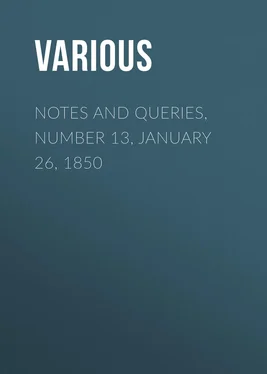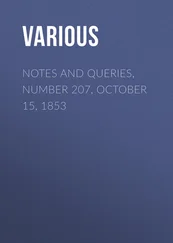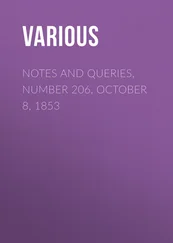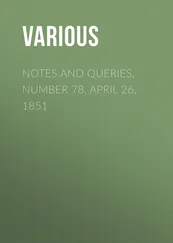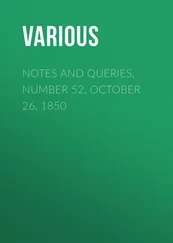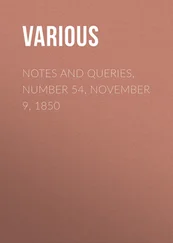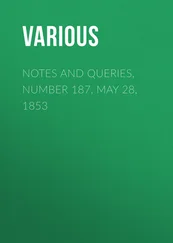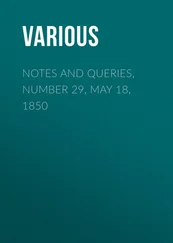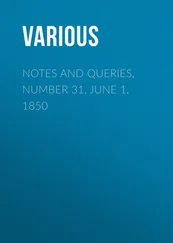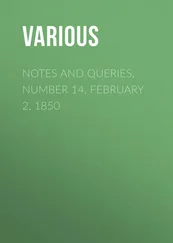Various - Notes and Queries, Number 13, January 26, 1850
Здесь есть возможность читать онлайн «Various - Notes and Queries, Number 13, January 26, 1850» — ознакомительный отрывок электронной книги совершенно бесплатно, а после прочтения отрывка купить полную версию. В некоторых случаях можно слушать аудио, скачать через торрент в формате fb2 и присутствует краткое содержание. Жанр: foreign_antique, periodic, foreign_edu, на английском языке. Описание произведения, (предисловие) а так же отзывы посетителей доступны на портале библиотеки ЛибКат.
- Название:Notes and Queries, Number 13, January 26, 1850
- Автор:
- Жанр:
- Год:неизвестен
- ISBN:нет данных
- Рейтинг книги:4 / 5. Голосов: 1
-
Избранное:Добавить в избранное
- Отзывы:
-
Ваша оценка:
- 80
- 1
- 2
- 3
- 4
- 5
Notes and Queries, Number 13, January 26, 1850: краткое содержание, описание и аннотация
Предлагаем к чтению аннотацию, описание, краткое содержание или предисловие (зависит от того, что написал сам автор книги «Notes and Queries, Number 13, January 26, 1850»). Если вы не нашли необходимую информацию о книге — напишите в комментариях, мы постараемся отыскать её.
Notes and Queries, Number 13, January 26, 1850 — читать онлайн ознакомительный отрывок
Ниже представлен текст книги, разбитый по страницам. Система сохранения места последней прочитанной страницы, позволяет с удобством читать онлайн бесплатно книгу «Notes and Queries, Number 13, January 26, 1850», без необходимости каждый раз заново искать на чём Вы остановились. Поставьте закладку, и сможете в любой момент перейти на страницу, на которой закончили чтение.
Интервал:
Закладка:
other neccessaries belonging to the saide
loft xiiij l . xiij s . ix d .
Item, paide to a paynter for payntyng the
same xij d .
"1562. For bearinge stones for the muringe up of the
dore of the late rood lofte viij d ."
The rapacious Puritans, of course, did not suffer any portion of the church-goods to escape their sacrilegious and itching palms, if convertible into money, so we read—
"1645. Received of Arthur Condall in part of 5li for
the screen and Organ-loft 1 s ."
MACKENZIE WALCOTT, M.A.S.M.W., Dec. 22. 1849.
NOTES UPON CUNNINGHAM'S HANDBOOK FOR LONDON
The Bagnio in Long Acre. —Mr. Cunningham mentions the Queen's Bagnio in Long Acre. Query, was this the same as the Duke of York's Bagnio? S. Haworth published, in a small 12mo. volume, without date, "A Description of the Duke of York's Bagnio, in Long Acre, and of the Mineral Bath and new Spaw thereunto belonging."
Tavistock Street, Covent Garden. —Richard Leveridge, the celebrated singer, after his retirement from the stage, kept a tavern in this street. Here he brought out "A Collection of Songs, with the Music, by Mr. Leveridge. In two volumes. London, Engrav'd and Printed for the Author in Tavistock Street, Covent Garden, 1727." The frontispiece was designed and engraved by Hogarth.
Duke Street, Westminster. —Miss Hawkins, in her Anecdotes , p. 186., speaking of Lady Lucy Meyrick, says, "On quitting her husband's family, she came to reside in Duke Street, Westminster, and lived in that house which had been Prior's , and which exactly faces Charles Street ."
Richmond Buildings, Soho. —Horne Tooke resided here in 1775. He afterwards removed to Frith Street.
Clare Market , originally called New Market , was established about the year 1660, by Lord Clare.
"The city and my lord had a great lawsuit, which lasted many years, to the great expence of the city; but from the inequity of the times the city and my lord agreed, and gave it up to the lord; and now it is become one of the greatest markets in the adjacent parts; and from the success of this noble lord, they have got several charters for the erecting of several others since the year 1660; as that of St. James, by the Earl of St. Alban's; Bloomsbury, by the Earl of Southampton; Brook Market, by the Lord Brook; Hungerford Market; Newport Market; besides the Hay Market, New Charingcross, and that at Petty France at Westminster, with their Mayfair in the fields behind Piccadilly."— Harl. MS . 5900.
London House Yard. —Here was formerly the town house of the Bishop of London, which, being consumed in the great fire, the house in Aldersgate Street, formerly called Petre House , was rented for the town residence of the bishop, since which it obtained the title of London House .
EDWARD F. RIMBAULT.OLD PAINTED GLASS
For poor ignorant people like myself pray insert the following, as perhaps some of your heraldic correspondents may afford some information for the benefit of your very humble servant,
F.E.Newington, June 17. 1751.
To take an account of what Coats of Arms or other Paintings are in the windows of the House Mercer lives of Mr. Filmer.
Painted Glass in y' windows at Mr. Merser House is
As foloweth 5 Coote of armse in 3 windowse in y'
Kichen 2 Surkelor Coots of armse 6 Lians traveling
6 flours of Luse all Rede & a Holfe Surkel a top
With 2 flours of luce y' Glass painted Rede
Blew yoler & of a Green Shaye.
In y' Hall one ouel Pease of Painted Glass
In Chakers of yoler & Green & blew 10 yong
Hedge frougs
Two Pikse of Armse on Each Side
W.B. there was in this Rote on y'
Glass Lyfford but there is only now ford y' 3 fust Leters ar Broken & Lost oute
One Pecs of y' Painted Glass in y' frount
Chamber window as foloweth
In a Surkel 6 flours of Luse 6 Red Lyans
Traveling 4 Rede Roses 2 Purpul Roses
With a Croune a tope with 2 flours of Luse &
A Crass and Beedse all Round y' Crowne.
In y' same window one more Cootse of arms
In a Surkel Devidet is as foloweth 3 yoler
Lyans passant 8 8 Corrections in the original.
Set in a Silver Coler 6 flours of
Luse
blew Sete in Green, y' Seoch Coote of arms on
Each Side y' thisel & Crown & y' 3 flours coming
out of the thistle
y' Croun yoler & y' flours y'e thisal of a silver Coler
3 Leopards 9 9 Corrections in the original.
Hedse Silver & Set in Silver
2 Roses of a purpul Couler one on Each Side
2 Spred Eaguls one on Each Side
& 2 Wingse of a Goos in y' midel of y' arms
of a Goold culer & a vessel like a decanter between
y'm
A croun a toupe with 2 flours of Luse on
Each side of y'e Croun on Crass in y'e middel & 2
holfe
Crasses on Each Side with white Beadse
all Round y'e Crounde a toupe.
AELFRIC'S COLLOQUY
The singular error which Messrs. Lye and Thorpe have fallen in the passage pointed out by Mr. Hampson in Aelfric's very interesting Colloquy , is the more remarkable as Aelfric himself afforded a complete illustration of the passage, in his Glossary , where we have "BULGA, hýdig-faet ." It is possible, therefore, that higdifatu is a mere error of the scribe. Now Du Cange, v. Bulga , cites this very passage from Aelfric's Glossary , and adds, "i.e. vas ex corio confectum ," but his whole article is worth consulting. That the Latin word in the Colloquy should be Cassidilia is quite clear. Thus in an old MS. English Gloss on the Bible (penes me), the passage in Tobit, viii. 2., "Protulit de Cassidili suo," is rendered, "brouzt forth of his Scrippe ." Coverdale has it, "take out of his bagge ," and Luther, "langte aus seinem Sücklein ," which word is exchanged for büdel in the Saxon version. In two old Teutonic Glosses on the Bible published by Graff ( Diutiska , ii. 178.), we have the following variations:—
de cassidi burssa, de sacello t. sacciperio kiula
de cassili burissa, de sacello t. sacciperio kiulla.
Another Gloss in Graff's 1st vol. p. 192., on the word Cadus , may perhaps throw some light on the subject. The philological student need not be reminded of the wide application of the word vas , Lat., fazz , O.G., and faet . A.S.; but for my own part, I conclude that the shoewright intended to designate by higdifatu all sorts of leathern budgets . Every Anglo-Saxon student must be so sensible of the great obligation he is under to our distinguished scholar Mr. Thorpe, that I trust it will not be deemed invidious or ungracious to point out another passage in this Colloquy which seems to have hitherto baffled him, but which it appears to me may be elucidated.
To the question, "Hwilce fixas gefehst thu?" the fisherman answers, "Aelas aud hacodas, mynas, aud aelputan, sceotan aud lampredan, aud swa hwylce swa on waetere swymath, sprote ."
Mr. Thorpe, in the 1st edition of his Analecta , says, "What is intended to be meant by this word [ sprote ], as well as by salu [the correspondent word in the Latin], I am at a loss to conjecture." In his second edition, Mr. Thorpe repeats, "I am unable to explain salu otherwise than by supposing it may be an error for salice . In his Glossary he has "spro't, ii. 2.? sprout, rod?" with a reference to his note. I must confess I cannot see how the substitution of salice for salu would make the passage more intelligible, and the explanation of spro'te in the Glossary does not help us. The sense required appears to me to be, quickly, swiftly, and this will, I think, be found to be the meaning of sprote . In the Moeso-Gothic Gospels the word sprauto occurs several times and always in the sense of cito, subito ; and though we have hitherto, I believe, no other example in Anglo-Saxon of this adverbial use of the word, we are warranted, I think, in concluding, from the analogy of a cognate language, that it did exist. In regard to the evidently corrupt Latin word salu , I have nothing better to offer than the forlorn conjecture that, in monkish Latin, " saltu't " may have been contractedly written for saltuatim ."
Читать дальшеИнтервал:
Закладка:
Похожие книги на «Notes and Queries, Number 13, January 26, 1850»
Представляем Вашему вниманию похожие книги на «Notes and Queries, Number 13, January 26, 1850» списком для выбора. Мы отобрали схожую по названию и смыслу литературу в надежде предоставить читателям больше вариантов отыскать новые, интересные, ещё непрочитанные произведения.
Обсуждение, отзывы о книге «Notes and Queries, Number 13, January 26, 1850» и просто собственные мнения читателей. Оставьте ваши комментарии, напишите, что Вы думаете о произведении, его смысле или главных героях. Укажите что конкретно понравилось, а что нет, и почему Вы так считаете.
